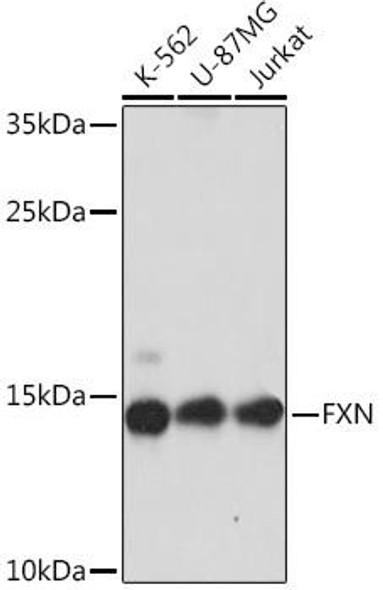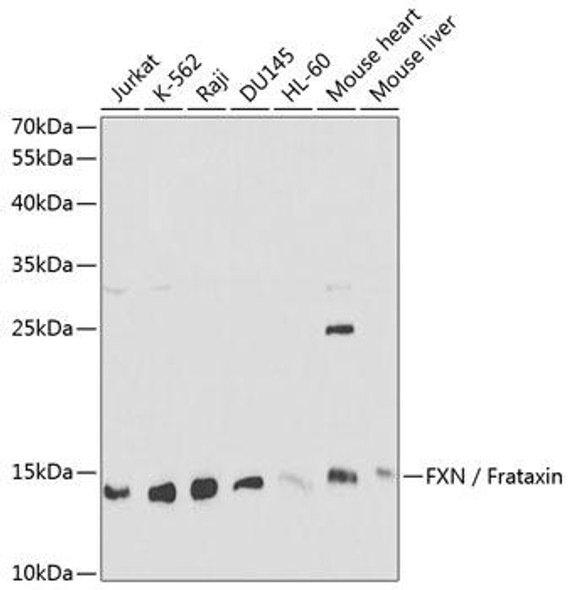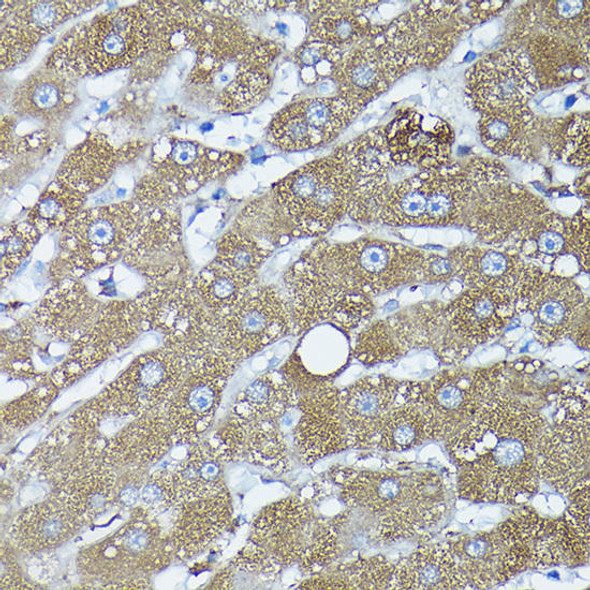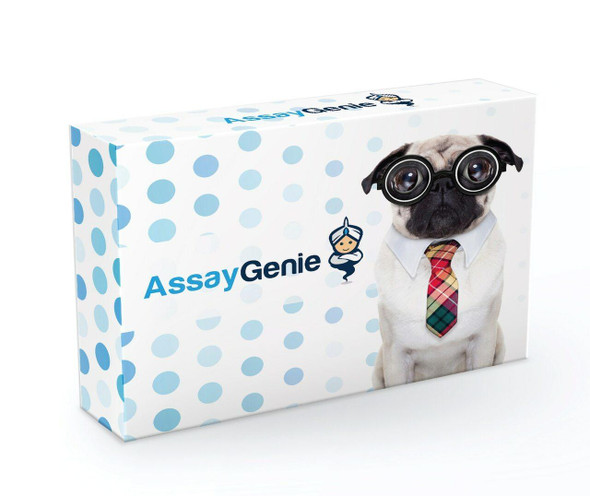Description
Fxn Antibody (PACO26849)
The FXN Polyclonal Antibody (PACO26849) is a valuable tool for researchers studying FXN, a protein involved in mitochondrial function and iron-sulfur cluster biosynthesis. This antibody, generated in rabbits, demonstrates high specificity and sensitivity towards FXN protein in human samples, making it suitable for use in Western blot applications. By targeting FXN, researchers can explore the role of this protein in mitochondrial function and its implications in various diseases, particularly those related to mitochondrial dysfunction.
FXN, also known as frataxin, is a crucial player in maintaining mitochondrial health by regulating iron metabolism and oxidative stress. Dysregulation of FXN has been linked to diseases such as Friedreich's ataxia, a neurodegenerative disorder affecting the nervous system and heart. Understanding the functions of FXN through targeted antibody detection is essential for uncovering new insights into mitochondrial diseases and developing potential therapeutic strategies to combat them.
| Antibody Name: | Fxn Antibody (PACO26849) |
| Antibody SKU: | PACO26849 |
| Size: | 50ug |
| Host Species: | Rabbit |
| Tested Applications: | ELISA, WB |
| Recommended Dilutions: | ELISA:1:2000-1:10000, WB:1:500-1:5000 |
| Species Reactivity: | Mouse, Human |
| Immunogen: | Recombinant Mouse Frataxin, mitochondrial protein (78-207AA) |
| Form: | Liquid |
| Storage Buffer: | Preservative: 0.03% Proclin 300 Constituents: 50% Glycerol, 0.01M PBS, PH 7.4 |
| Purification Method: | >95%, Protein G purified |
| Clonality: | Polyclonal |
| Isotype: | IgG |
| Conjugate: | Non-conjugated |
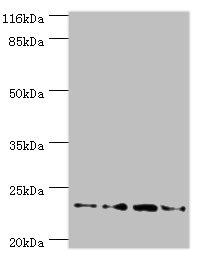 | Western blot All lanes: Fxn antibody at 2µg/ml Lane 1: HepG2 whole cell lysate Lane 2: Hela whole cell lysate Lane 3: Mouse brain tissue Lane 4: Jurkat whole cell lysate Secondary Goat polyclonal to rabbit IgG at 1/10000 dilution Predicted band size: 23 kDa Observed band size: 23 kDa . |
| Background: | Promotes the biosynthesis of heme and assembly and repair of iron-sulfur clusters by delivering Fe2+ to proteins involved in these pathways. May play a role in the protection against iron-catalyzed oxidative stress through its ability to catalyze the oxidation of Fe2+ to Fe3+; the oligomeric form but not the monomeric form has in vitro ferroxidase activity. May be able to store large amounts of iron in the form of a ferrihydrite mineral by oligomerization. Modulates the RNA-binding activity of ACO1 (By similarity). |
| Synonyms: | Frataxin, mitochondrial (Fxn) (EC 1.16.3.1) [Cleaved into: Frataxin intermediate form; Frataxin mature form], Fxn, Frda |
| UniProt Protein Function: | FXN: Promotes the biosynthesis of heme and assembly and repair of iron-sulfur clusters by delivering Fe(2+) to proteins involved in these pathways. May play a role in the protection against iron-catalyzed oxidative stress through its ability to catalyze the oxidation of Fe(2+) to Fe(3+); the oligomeric form but not the monomeric form has in vitro ferroxidase activity. May be able to store large amounts of iron in the form of a ferrihydrite mineral by oligomerization; however, the physiological relevance is unsure as reports are conflicting and the function has only been shown using heterologous overexpression systems. Modulates the RNA-binding activity of ACO1. Defects in FXN are the cause of Friedreich ataxia (FRDA). FRDA is an autosomal recessive, progressive degenerative disease characterized by neurodegeneration and cardiomyopathy it is the most common inherited ataxia. The disorder is usually manifest before adolescence and is generally characterized by incoordination of limb movements, dysarthria, nystagmus, diminished or absent tendon reflexes, Babinski sign, impairment of position and vibratory senses, scoliosis, pes cavus, and hammer toe. In most patients, FRDA is due to GAA triplet repeat expansions in the first intron of the frataxin gene. But in some cases the disease is due to mutations in the coding region. Belongs to the frataxin family. 2 isoforms of the human protein are produced by alternative splicing.Protein type: EC 1.16.3.1; Mitochondrial; Motility/polarity/chemotaxisChromosomal Location of Human Ortholog: 19|19 BCellular Component: cytoplasm; cytosol; mitochondrionMolecular Function: 2 iron, 2 sulfur cluster binding; enzyme binding; ferric iron binding; ferrous iron binding; ferroxidase activity; iron-sulfur cluster binding; metal ion binding; oxidoreductase activityBiological Process: adult walking behavior; aerobic respiration; cellular iron ion homeostasis; embryonic development ending in birth or egg hatching; heme biosynthetic process; ion transport; iron incorporation into metallo-sulfur cluster; iron ion homeostasis; iron-sulfur cluster assembly; mitochondrion organization; negative regulation of apoptosis; negative regulation of multicellular organism growth; negative regulation of organ growth; oxidative phosphorylation; positive regulation of axon extension; positive regulation of catalytic activity; positive regulation of cell growth; positive regulation of cell proliferation; positive regulation of lyase activity; proprioception; protein autoprocessing; response to iron ion; transport |
| UniProt Protein Details: | |
| NCBI Summary: | |
| UniProt Code: | O35943 |
| NCBI GenInfo Identifier: | 6679863 |
| NCBI Gene ID: | 14297 |
| NCBI Accession: | NP_032070.1 |
| UniProt Secondary Accession: | O35943 |
| UniProt Related Accession: | O35943 |
| Molecular Weight: | |
| NCBI Full Name: | frataxin, mitochondrial |
| NCBI Synonym Full Names: | frataxin |
| NCBI Official Symbol: | Fxn |
| NCBI Official Synonym Symbols: | FA; X25; FARR; Frda |
| NCBI Protein Information: | frataxin, mitochondrial |
| UniProt Protein Name: | Frataxin, mitochondrial |
| UniProt Synonym Protein Names: | |
| Protein Family: | Frataxin |
| UniProt Gene Name: | Fxn |
| UniProt Entry Name: |



